

Ultimate Guide About Thickener
2019-05-22 19:36:17xinhai
The quality of thickener will directly affect the result of dewatering operation, and high-quality thickener will increase 20%-30% thickening concentration,then strengthen thickening result.
In the current ore dressing process, most mineral processing plant adopt wet separation process, so the concentrate has very high-water content, which can't be smelted directly. As the first step of dewatering operation, thickening operation occupies 9% influences on the whole beneficiation process, and 35% effects on the whole dewatering operation. The quality of thickener will directly affect the result of dewatering operation, and high-quality thickener will increase 20%-30% thickening concentration, then strengthen thickening result.
In practice, the common thickening equipment includes: rake thickener, high-efficient thickener, deep cone thickener, titled plate thickener.
Rake thickener can be divided into central driving thickener and peripheral transmission thickener according to the transmission mode, and it is one of the common thickening equipment used in the thickening and dehydration operation of mineral processing plant.
Rake thickener has large processing capacity, wide range of feeding concentration, higher concentration of concentrated product and lower solid content of overflow. The feeding concentration of concentrate is generally 20%-30%, the feeding concentration of tailings is 2%-10%; When concentrate is concentrated, the underflow concentration is often up to 30%-70%, and the solid content in the overflow is usually 0.1-0.5 g/L. In addition, rake thickener is featured with reliable operation, low power consumption but large floor space.
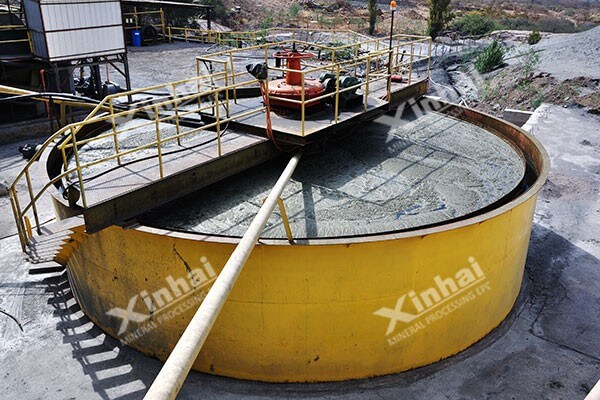
1. Central driving thickener
The main components of the rake thickener are the tank body, rake arm, rake arm transmission mechanism, rake arm lifting device, overload warning mechanism, feeding system and unloading system, etc.
The tank body is cylindrical shape and reinforced concrete structure. The bottom of the tank body is a cone bottom with flat bottom or a conical bottom (<12 degrees), and the central part is provided with a discharge hopper for the concentrated product, which is connected with the underflow conveying system. The upper part is connected with annular overflow groove.
2. Peripheral transmission thickener
Peripheral transmission thickener consists of round thickener and harrow scraping machine, the solid particles suspend in thickener settling by gravity, the pulp in the upper turn into clean water, so that the separation can be realized. Slime that sediment in the bottom of the thickener is discharged by the harrow scrapping continuously, and clean overflow from the upside.
Peripheral transmission covers peripheral roller transmission and peripheral gear transmission two forms that has advantages of high safety factor, stable and reliable running, easy to operation, convenient maintenance and long-range control. It can fully meet various operation requirements. In addition, Xinhai specially selects single row cross column rotary support or single row four point contact ball rotary support, which not only possess compact structure, light weight, but also can bear larger axial force, radial force and overturning moment.
One end of the truss connected to the rake arm is assisted by a special bearing and placed on the central column, and the other end is connected to the transmission trolley. The roller wheel of the trolley is driven by the motor of the reducer and gear device, so that the truss walks along the track. If the resistance of the rake arm is too much, the roller slips,and the rake arm stops, so it is not necessary to set up a special overload protection device for peripheral transmission thickener. Because the roller is easy to slip, the specification of peripheral transmission thickener should not be too large.
High-efficient thickener consists of round thickener and harrow scrapping machine, the solid particles suspend in thickener settling by gravity, the pulp in the upper turn into clean water, so that the separation can be realized. Slime that sediment in the bottom of the thickener is discharged by the harrow scrapping continuously, and clean overflow from the upside.
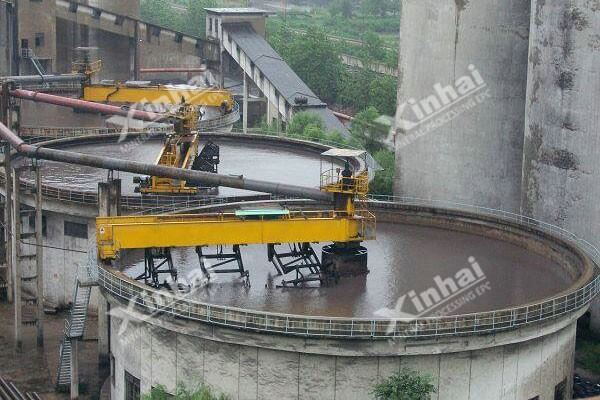
Xinhai adopts new mechanical structure that greatly strengthens the flocculation of flocculating agent on solid particles.At the same time, new flocculent addition system increases the particle size of sedimentary solid particles, then accelerated the settling velocity; Compared with conventional thickener, this thickener is has higher production efficiency, 2-3 times unit processing capacity and 30% energy saving, which can effectively deal with all kinds of slurry, waste water and waste residue.
The features of high-efficient thickener include:
1. Add a certain amount of flocculant to the thickening material to make the solid particles in the pulp form flocculation or agglomeration, so as to accelerate the sedimentation rate and improve the thickening efficiency;
2. Extend the feeding barrel downward, so the flocculating slurry can be delivered under the sedimentation and clarification area;
3. Set the automatic control system to control the dosage and underflow density.
Deep cone thickener also called paste thickener is higher than other thickeners which consists of deep cone, feeding device, stirring device, control box, reagents adding device, automatic control system, etc.
The structure of the deep cone thickener is that its depth of the pool is large than the diameter of the pool. The deep cone thickener is vertical cone. Flocculant is usually added when the deep cone thickener is working.
Because the depth of the pool is larger than the diameter, and the flocculant effect, the processing capacity of deep cone thickener is very large. Compared with the rake thickener, the processing capacity of unit area is several times, even dozens of times larger than the rake thickener, which can reach 2-4 m3/(m2h); And because of the long settling time, the underflow product with high concentration can be obtained.
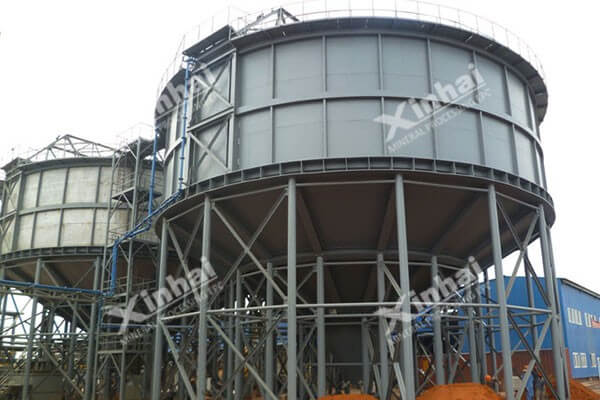
Xinhai adopts large angle cone design and the whole is vertical cone shape, which greatly improves underflow density and overflow quality; At the same time, both slender pool body design and flocculating agent accelerate the concentration process, reduce the floor space and improve automation degree.The processing capacity is 3-8 times higher than traditional thickener, and the underflow concentration is as high as 50-70%, which can satisfy the high thickening requirement and fine-grained slurry thickening.
Tilted plate thickener is a kind of center driving rake thickener. The titled plate is installed at the bottom of the clear zone, the slurry moves forward the inclined top along the thickening board space after fed through the feeding tube, the particles settles vertically between the plates. Because to the subsidence distance is very short, the settling time is reduced greatly, which strengthens the thickening effect. The particles that settles on the plate glides, and deposit at the bottom of the thickener,the overflow quality is also further improved.
Firstly, mineral liquid is mixed uniformly and then carried into thickener. Secondly, by the action of cohesive and gravitational force, the majority of overflows are overflowed through the overflow groove. The minority of overflows form small cyclone inside the settling area and subsequently are compressed in the compressive area. As a result, granules are compressed by gravity and then fall down, while clear liquid moves upward. Finally, concentrations are discharged from the lower underflow tube.
Advantages: simple structure, easy to manufacture,low energy consumption, high production capacity of unit area, high thickening efficiency.
Disadvantages: Not suitable for large scale,small processing capacity of single unit set.
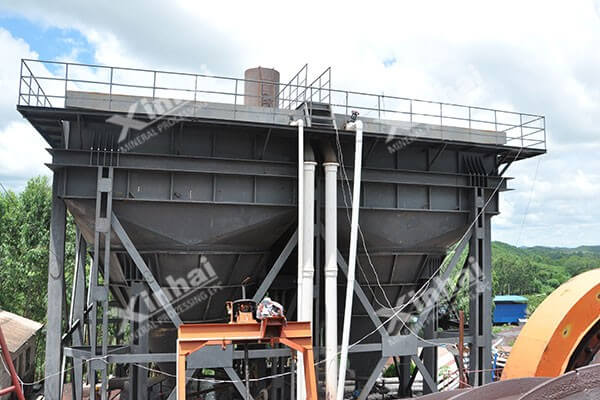
Based on the slow sedimentation rate of traditional inclined plate thickener, Xinhai improves plate channel integration and plate modularity on tilted plate thickener, which not only can keep the identity, but also can adopt deformation design according to slurry properties and separation size, maximally play the thickener performances; Besides, Xinhai set the vibrator on the outer wall of cone bucket, which accelerates the declining of ore grain, prevents pulp congestion and achieves forced discharge of high concentration underflow. The underflow concentration can reach 70%. It is suitable for tailings flotation and all kinds of solid-contained slurry.
According to the process requirements, the nature of materials and the different conditions, the following principles should be considered when selecting the type and model of thickener:
1. Center driving thickener and peripheral transmission thickener are generally adopted for dewatering and dedosing operations. When the processing capacity is not large, center driving thickener should be preferred to be choose; When the processing capacity is large,peripheral transmission thickener is usually adopted. When the material density is small, roller thickener can be given priority, otherwise rack thickener.
2. Multi-layer thickener is generally used in the washing and precipitation operations in gold cyanide plant (or wet smelting plant).
3. High-efficient thickener can be selected when in the plant is located in the narrow and cold area. However, due to the problems of using flocculant and its influence on the next process, the reliable test data must be obtained when selecting.
4. Generally, the feed size of the thickener shall be less than 250μm. If the feed size cannot be reduced. It should be considered to first make the pulp carry on mechanical classification,centrifuge or cyclone processing. Then, the separated coarse grains are sent to the thickener.
5. The production capacity or required sedimentation area of the thickener shall be determined according to the material sedimentation test.
6. Titled plate thickener can be used for the concentrate thickening in small mineral processing plant and sewage purification operation.
The sediment separation of medium particles is based on the density difference between the dispersed phase and the continuous phase. The separation effect is also related to the size, shape,concentration of the dispersed phase particles, the viscosity of the continuous phase, the type and dosage of flocculant, the sediment area, the sediment distance and the residence time of materials in the sediment tank.
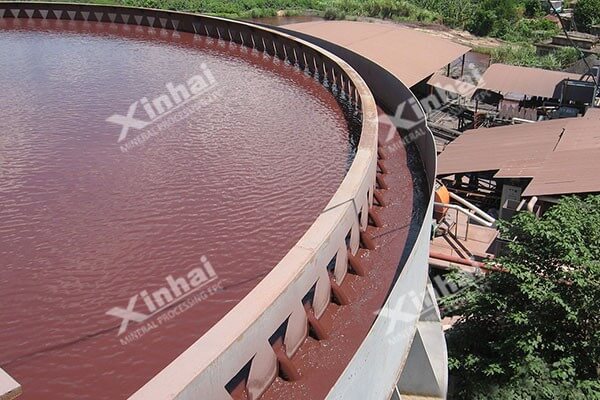
1. Property of particles
For the same solid, the coarse particles settle faster than the fine ones. Spherical or nearly spherical particles settle faster than non-spherical particles within the same volume. The orientation of non-spherical particles and the deformation of deformable particles will affect the settling velocity.
2. Particle concentration in the suspension system
Increase the number of uniformly dispersed particles in the liquid, which can reduce the settling rate of each individual particle.
3. Property of medium
For the certain solid particles, the density and viscosity of the medium have a significant impact on these dimentation velocity. The greater the density difference between the medium and particles, the smaller the viscosity of the medium, and the greater the sedimentation velocity of the particles. The viscosity of the medium will decrease as the temperature increases. Therefore, the sedimentation rate can be changed by adjusting the temperature.
4. Type and dosage of flocculant
Adopting flocculants should depend on the specific situation. For example, using the lime as the flocculant in some of the suspending liquid, the clarify operation will take several hours, while using the allyl polymer flocculant as the flocculant, the clarify time can be reduced to 15 min.
5. Sediment vessel
The separation efficiency of the settling tank (such as the clarity of the liquid) will be improved with the increasing of the residence time of the material in the vessel, but the extension of time means the processing capacity decreases. In addition, the processing capacity of the sediment tank is proportional to the sediment area. Shortening the sediment distance of particles can improve the sediment capacity or clarification without extending the sediment time or increasing the sediment area. In addition, shortening the sediment distance means reducing the required sediment space without changing the required area, so the titled plate thickener is developed.
The daily maintenance of thickener requires full-time staff to perform daily inspections, machine lubrication,regular maintenance. In addition, the maintenance personnel should be able to handle emergencies; all qualified maintenance personnel can ensure the thickener works stably.
1. Thickener Daily Inspection
Daily inspection is an indispensable process for large-scale equipment. It is necessary for the on-the-job personnel to understand the structure, performance, specifications, names, and functions of various components. They are familiar with the entire process of equipment operation, to carry out inspection and maintenance operations.
(1) Check the bolts of all parts of thickener on a daily basis to see whether there are any rust and broken screws.
(2) Check whether the hydraulic cylinder has leakage phenomenon; whether the bearing has deformation phenomenon; whether the transmission gear has broken teeth, whether the tooth plate has broken teeth or rust.
(3) Check whether the thickener drive chain is tight; the scorpion has deformation or breakage.
(4) Check the oil level, whether it is above the middle of the oil window. If it is lower than the middle of the oil window,it is necessary to fill the oil in time.
(5) Check the bearing temperature, no more than 80 °C; the motor temperature doesn’t exceed 65 °C; the temperature of the center mixing reducer and whether there is oil leakage.
If serious problem occurs in the above daily inspection,the machine needs to be shut down and problems must be reported to the superior.
2. Thickener Machine Lubrication
Lubrication management of thickener is the key point. The lubrication of thickener should be checked correctly, reasonably and in timely manner. The oil level of fuel tank should be checked every day and replenished if it’s necessary. The lubricating oil used in different lubrication time of thickener is different and the oil is also changed according to the seasons.
(1) The oil for hydraulic motor reducer is N150-220 industrial gear oil.
(2) The oil used in the gearbox is N150-460 industrial gear oil.
(3) In the hydraulic station, the summer oil is N46 anti-wear hydraulic oil, and the winter oil is N32 anti-wear hydraulic oil.
Each lubrication point needs to be replaced with new oil after the first refueling operation, and the lubricant should be replaced every six months. It’s usually necessary to check the oil level daily and replenish oil in time.
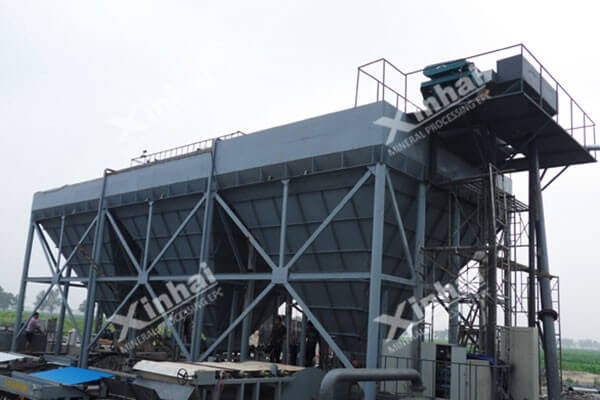
3. Thickener Regular Maintenance
Maintenance Items
(1) Regularly repair the thickener fasteners, drive racks, and slide.
(2) Regularly overhaul the track of turning and lifting, ensure the diameter error of the center circle is ≤±5 mm, and ensure the top surfaces of the two sections of are on the same plane (the error is not more than 0.5 mm, and the unevenness of the track at each end cannot exceed 1.5 mm) ).
(3) Regularly check the wear of the support rollers, roller bearings and transmission gears. If necessary, change the surface or replace it directly.
(4) Regularly check the slurry pipe, elbow,center barrel, trough frame, transmission frame, thickener truss and replace the damaged parts in time.
(5) Regularly check the changes of running motor ammeter. If the change is obvious, please check the operation of each part in time.
Maintenance Cycle
Maintenance Category | Maintenance Cycle (h) | Repair Content |
Minor repair | 4000 | Minor Repairs Content Drain the mortar in the thickener and check swash plate and inner plate of the tank for damage; Check whether the maintenance mechanism is in good condition; Check all welds are in good condition; |
Overhaul | 8000 | Check the fastening anchor bolts; Check outer surface of the tank shell for oil leakage; Clean up dirt and debris on the track; Clear the leakage of pipeline valves and joints; Check the bite of the gear and roller; |
4. Thickener Emergency Handling Method
Common Malfunctions | Emergency Treatment |
"Compression" Failure | “Pressure” is mainly caused by blockage of the slurry line or long-term stoppage. It is necessary to stop the feed, and then rinse the discharge port with water of 0.5~0.8 MPa. |
Overflow Water Quality Deteriorates | Adjust level of the zigzag ; Concentrated sloping plate has ash accumulation, requiring water to rinse; There are floating objects in the overflow pool and cleaned up. The amount of ash entering the slurry becomes large and needs to be adjusted into slurry. |
Large Material Concentration | The discharge port can be adjusted appropriately to increase the displacement |
Different Sound of Pressure Bearing | Need to stop the inspection in time to ensure all lubrication points are properly lubricated. |
The oil pump turns wrong | It may be the oil pipe has air in, the direction of rotation needs to be changed. |
In the daily operation of thickener,emergencies often occur. If not handled properly, the overall efficiency of the processing plant will be affected. Therefore, it’s necessary for the on-the-job personnel to find problems and deal with problems in time.
In order to ensure the normal operation of the thickener in the processing plant and maintain its normal working efficiency, the maintenance and inspection of thickener is indispensable, and the requirements for the on-the-job personnel are also extremely strict.